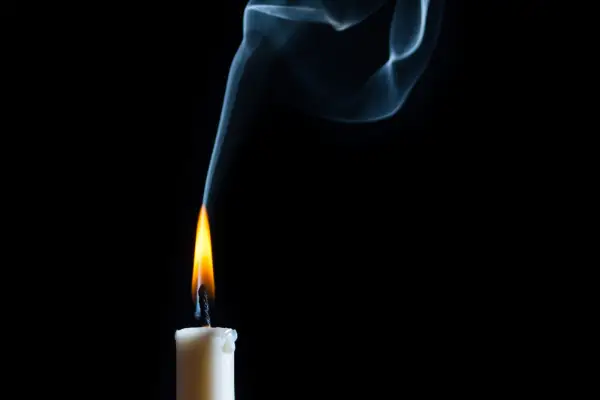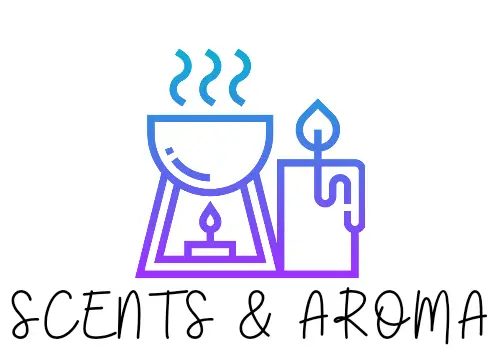Candles have a long history. It’s believed that the Romans made the first candles around 500 BC.
Candles nowadays are still very similar to the ones our ancestors used – and that’s because they work so well.
While we may no longer need them for light, you can’t beat the warm glow and mesmerizing scent of a flickering candle. But, many people often wonder how exactly do candles work and does candle wax evaporate?

If you’ve ever wondered, ‘does candle wax evaporate?’ The short answer is, candle Wax does indeed evaporate as the candle burns. The wax acts as a fuel for the burning wick and slowly heats up until it reaches its evaporation temperature, that is why you will notice that after a while of burning your candle reduces in size.
Let’s take a look in more detail at how candles work and what happens to the wax.
Candle structure
Candles have a rather simple structure. Essentially, they’re just a wick surrounded by wax. Candle wax itself is made of hydrocarbons from fats.
These hydrocarbons are perfect for candles as they liquefy easily and can store lots of energy.
Back in ancient Rome, the Romans used rendered beef fat called tallow for candle wax, while in Ancient China, they used both whale fat and beeswax. In India, it was boiled cinnamon tree fruit, and in Japan, tree nut extracts.
Nowadays, most candles are made from paraffin wax, but more natural waxes like soy wax and beeswax are becoming more common.
Paraffin wax
Since paraffin wax is the most common of candle waxes, we’ll take a look at what it is exactly.
Paraffin wax is also called petroleum wax since it is made from petroleum. It is soft and has a white appearance and no smell. It is made of hydrocarbons, with each molecule containing 20-40 carbon atoms.
(Did you know that paraffin wax is slightly toxic? Check out this article I wrote that will explain more!)
Paraffin wax is a solid at room temperature and will start to melt when it reaches around 37°C. It boils at 370°C. As well as candles, paraffin wax is used in electrical insulation and lubrication. It is also dyed for making crayons.
This substance was created in 1830 in Germany by Carl Reichenbach, who was a chemist and geologist. Reichenbach’s creation was a huge boost for candlemakers as it was more reliable, burned more cleanly, and was cheaper than tallow.
The name paraffin is derived from parum, which means ‘very little’ in Latin and affinis, meaning ‘lacking reactivity’.
How is paraffin wax made?
When lubricating oil is refined, a substance called slack wax is produced as a byproduct. It is this byproduct that goes into the manufacture of paraffin wax.
Firstly, the oil is removed from the slack wax by crystallization. This happens by heating the slack wax and mixing it with a solvent like a ketone before cooling it.
When the mixture cools, wax crystallizes, and the oil is left. After being filtered, you are left with two products – liquid (a mix of oil and solvent) and solid (wax and solvent). The solvent gets recovered through distillation, leaving the wax behind.
How do candles burn?
If you ever look at a candle burning, it’s hard to tell what is going on. Is it the liquid wax that’s burning, the solid wax, the wick, or something else?
While a candle is made simply with just a wick and a stick of wax, the combustion process is much more complex.
Combustion is another word for burning. During a combustion reaction, the fuel is heated and reacts with oxygen gas. In candles, the fuel is the wax.
However, before the wax can be used as fuel, it needs to be hot enough. To begin the process of heating, the wick needs to be lit.
When the wick burns, the heat coming from the flame melts the surrounding wax. Since the wick is absorbent, this liquid wax is drawn upwards towards the flame.
After being a solid, then a liquid, the wax gets so hot that it becomes a gas. It is this hot gas that reacts with oxygen in the air and burns. The result is the flame we see.
The wick or the solid wax does not create the candle’s flame. Rather, it is the burning wax vapour that creates it. The flame is what keeps more wax (fuel) coming. Thus, the process is a cyclical one.
You may find sometimes that a candles flame can burn to high. If you notice this problem read my guide for information on how to stop it.
Is the wick material important?
If you were to touch a candlewick before it is placed into a candle, you would notice it is soft and very absorbent. This is because whatever the material used, it needs to be able to feed the flame with molten wax.
Candle wicks are usually made from braided cotton. The wick is important because it influences how a candle burns.
Therefore, candle makers pay close attention to the stiffness, diameter, tethering, and fire resistance of a wick.
Fire resistance is acutally really important. Without being pre-treated with a flame-resistant solution – a process called mordanting – the wick would burn completely and not allow the molten wax to flow up it.
Why do candles stop burning?
Whenever you light a candle, it will burn steadily until one of three things happen. The flame will extinguish, of course, if you blow out the flame, but it will also stop burning of its own accord when there is no more wax to burn or no more oxygen.
An experiment to test that the candle wax is evaporating.
If you’re in any doubt about how candles work and whether or not candle wax evaporates and burns, you can test the theory.
- Light the candle and wait a few seconds to allow it to burn and melt the wax.
- Blow out the candle and take note of the white smoke that escapes from the candlewick.
- Light the candle again and keep the match lit.
- Blow out the candle, then immediately after, hold the lit match into the white smoke. Don’t touch the wick.
- You should notice that the candle relights when you touch the white smoke (the wax vapour) with another flame. This is because the evaporated wax vapour is actually flammable.
What happens afterwards?
As we’ve said previously, candle wax is made of hydrocarbons – a mixture of hydrogen and carbon.
When candles burn, the carbon and hydrogen in the wax mix with oxygen in the air and turn into water vapour and carbon dioxide. Most waste products of a candle, therefore, are these gases.
In addition, around 0.1% of the candle turns into soot, smoke and other trace gases.
We don’t need to worry about water vapour and carbon dioxide being released into the air. At low levels, these make up a normal atmosphere in a room.
Candles produce such a small amount of both – it’s much less than the amount of water vapour and carbon dioxide a person will breathe out in the same room.
Final thoughts
So, in answer to the question ‘does candle wax evaporate?’ we can say yes.
However, it is then burnt as a part of the combustion process. As simple as candles are structurally, burning them is simply fascinating.
No matter the type of wax, the burning process is exactly the same. The only differences are in the substances released during burning, with paraffin wax being well-known for releasing carcinogens into the atmosphere.
- Can You Put Perfume In A Humidifier? (Read First) - September 17, 2022
- Can You Put Essential Oil In A Steam Mop? (Safety Advice) - September 17, 2022
- How To Make Lavender Oil At Home ( Candles And Diffusers) - September 9, 2022

